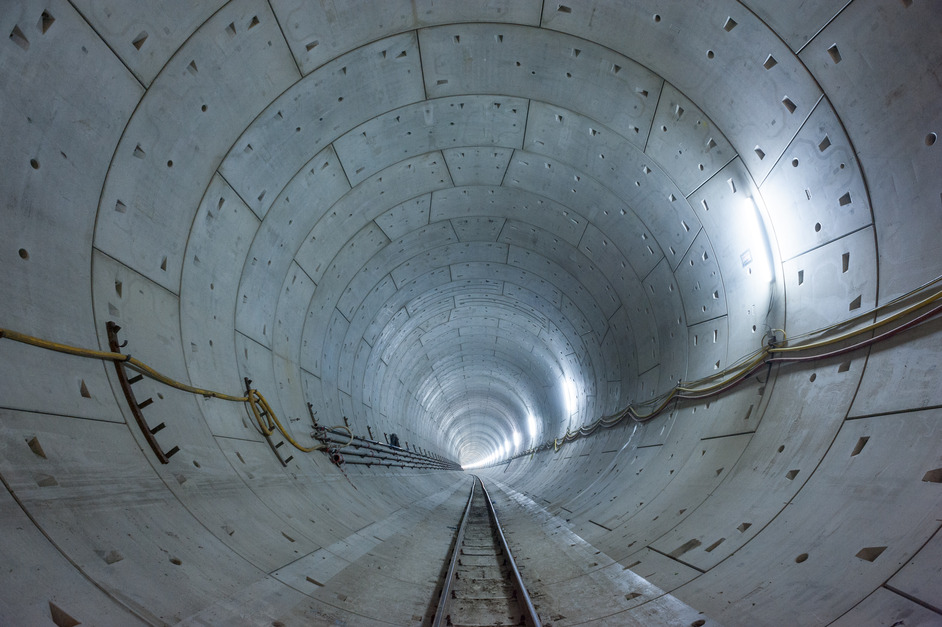The Stuttgart – Ulm railway project is part of the trans-European Paris – Budapest route. Upgrading the line to a high-speed link between Stuttgart and UIm means that not only will the remodelled existing sections of the line meet the highest requirements of a modern rail link, so too will the newly built parts of this major project. This large-scale project comprises construction of new railway infrastructure and the remodelling of the existing infrastructure in and around Stuttgart - widely known as Stuttgart 21 - and subsequently constructing the new line from Wendlingen to Ulm, which, as a high-speed link, will significantly reduce travel times.
Albaufstieg line implemented with a combined solution
The Bossler tunnel is part of the planning approval section PFA 2.2 on the new line from Wendlingen to Ulm, also known as the “Albaufstieg”. At approximately 8.8km long, the twin-tube railway tunnel is the largest structure in the PFA 2.2. It cuts through the rock strata of the Swabian Jura with a gradient of no less than 2.5%. The original plan was to excavate the entire Bossler tunnel using conventional blasting methods. A stratigraphic analysis showed that the rock layers were under pressure, ruling out a full excavation by means of a tunnel boring machine (TBM) from the outset. The Albaufstieg Tunnel Consortium (ATA), led by PORR, submitted a special secondary bid proposing a combination of mechanised tunnelling using a TBM and conventional partial tunnelling using jetcrete construction, which was ultimately accepted by Deutsche Bahn. A TBM with 4,550kW drive power was used to excavate the east tunnel from April 2015 to early November 2016. After the machine had been transferred to the adjacent west tube, tunnelling resumed in mid-April 2017 and was successfully completed by the beginning of June 2018 following after a record performance of 214 metres of tunnelling per week. Once the connecting structures, the inner lining and the tunnel portals had been completed, the individual components of the Bossler tunnel were handed over to the downstream trades responsible for installing the railway engineering systems from mid to late 2020. In addition to the Bossler tunnel, the roughly 4.85km-long twin-tube Steinbühl tunnel was also constructed along the Albaufstieg using conventional jetcrete construction under the lead management of PORR, and subsequently fitted with an in-situ concrete inner lining.
Challenging driving concept for the Filder tunnel
In Stuttgart itself, the ATCOST21 consortium, again led by PORR, is also constructing the approximately 9.5km-long twin-tube Filder tunnel from Stuttgart central railway station towards the airport, as well as the Obertürkheim/Untertürkheim access tunnels, which consist of two approximately 6km-long tunnel tubes. The access tunnels to Obertürkheim and Untertürkheim were the first four underground passages to be built under the Neckar River using the conventional jetcrete construction method, with distances to the riverbed ranging between 8.5m and 18m. The driving concept for the Filder tunnel was based on a special proposal submitted by the PORR tunnelling engineers and involved pulling the TBM through the 1.1km-long middle Filder tunnel and turning it around underground before the last shield drive. The entire tunnelling unit was transferred to the neighbouring tube in just three months. The two most spectacular days were those on which the shield component – 11m high, 11m wide and weighing 1,400t – was rotated through the 12m-wide and 13m-high turning cavern. These novel shunting and turning processes for a TBM including the trailing supports and logistics were among the project highlights for everyone involved.
PORR is also carrying out the downstream works for the installation of the slab track including a mass-spring suspension system in several tunnel sections, emergency lighting, and extensive cabling work in the Filder tunnel and the access road tunnels to Obertürkheim and Untertürkheim. This makes PORR a successful full-service project partner for the realisation of modern railway tunnels in all relevant areas.
